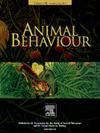冻结还是逃跑?蝌蚪的行为决定基于同种的化学警报提示
IF 2.1
2区 生物学
Q2 BEHAVIORAL SCIENCES
引用次数: 0
摘要
最佳的反捕食者策略对于猎物在不牺牲其环境中资源开发机会的情况下保持安全至关重要。这种优化需要灵活地适应不同的捕食情景,这反过来又需要对捕食风险进行某种评估,思考权衡,并选择行为曲目的某些组成部分作为响应。对于包括两栖动物幼虫在内的水生动物来说,化学感觉线索在探测危险和引发对危险的反应方面往往很重要。然而,化学线索的不同方面在多大程度上可以被感知、辨别、解释并用于形成反捕食者反应仍然未知。在这里,我们以蟾蜍的蝌蚪为实验模型来解决这个问题。我们将它们暴露在化学警报信号中,并控制其来源、浓度和空间分布。视频追踪每只被测试的蝌蚪,使我们能够对沙arenum幼虫的反捕食行为进行精确的分析,获得它们反捕食策略的细节,当蝌蚪在群体中进行测试或当分析仅限于活动的一般变化时,通常会遗漏这些细节。反应包括主动和被动的行为,包括冻结,逃跑(通常改变他们的游泳方向)和避开特定位置和时刻显示的区域。这表明蝌蚪可以从化学线索中提取不同类型的信息,并用它来调整它们的行为输出。此外,我们的研究结果表明,单一感官模式的线索变化足以调节相反的反捕食者反应,如冻结和飞行行为。本文章由计算机程序翻译,如有差异,请以英文原文为准。
Freeze or escape? Tadpoles' behavioural decisions based on conspecifics' chemical alarm cues
Optimal antipredator strategies are crucial for prey animals to stay safe without sacrificing opportunities for resource exploitation in their environment. Such optimization requires the flexibility to adapt to different predation scenarios, which in turn requires some kind of assessment of the predation risk, pondering trade-offs and selecting some component(s) of a behavioural repertoire to be displayed as responses. For aquatic animals, including amphibian larvae, chemosensory cues tend to be important in detecting danger and eliciting a response to it. However, the extent to which different aspects of chemical cues can be perceived, discriminated, interpreted and used to shape an antipredator response remains unknown. Here, we tackle the problem using tadpoles of the toad Rhinella arenarum as the experimental model. We exposed them to chemical alarm cues in which we manipulated the source, concentration and spatial distribution. Video-tracking individually tested tadpoles allowed us to perform a precise analysis of the antipredator behaviours in R. arenarum larvae, obtaining details of their antipredator strategy that are usually missed when tadpoles are tested in groups or when the analysis is restricted to the general change in activity. The responses included active and passive behaviours, including freezing, fleeing (usually changing their swimming direction) and avoiding areas displayed in specific locations and moments. This suggests that tadpoles can extract different types of information from chemical cues and use it to tune their behavioural outputs. Furthermore, our results show that cue variation in a single sensory modality can be sufficient to modulate opposing antipredator responses, such as freeze and flight behaviours.
求助全文
通过发布文献求助,成功后即可免费获取论文全文。
去求助
来源期刊

Animal Behaviour
生物-动物学
CiteScore
4.60
自引率
8.00%
发文量
236
审稿时长
10.2 weeks
期刊介绍:
Growing interest in behavioural biology and the international reputation of Animal Behaviour prompted an expansion to monthly publication in 1989. Animal Behaviour continues to be the journal of choice for biologists, ethologists, psychologists, physiologists, and veterinarians with an interest in the subject.
 求助内容:
求助内容: 应助结果提醒方式:
应助结果提醒方式:


